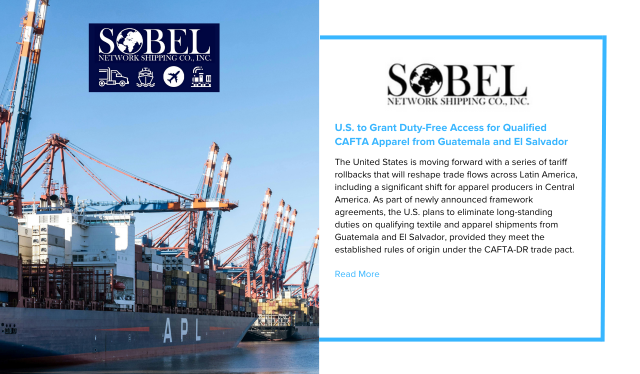The United States is moving forward with a series of tariff rollbacks that will reshape trade flows across Latin America, including a significant shift for apparel producers in Central America. As part of newly announced framework agreements, the U.S. plans to eliminate long-standing duties on qualifying textile and apparel shipments from Guatemala and El Salvador, provided they meet the established rules of origin under the CAFTA-DR trade pact.
These actions accompany broader tariff reductions on several agricultural commodities. The U.S. will remove 15% duties on bananas and cocoa from Ecuador and eliminate 10% duties on Guatemalan coffee and Argentine beef. The moves follow a September executive order that outlined categories of goods eligible for tariff relief if trading partners secured new reciprocal commitments.
What had not been anticipated was the inclusion of textile and apparel products, which have faced a 10% tariff despite meeting CAFTA-DR rules. The U.S. government explained that supply chains between the U.S. and Central America—particularly those involving U.S. cotton, yarn, and fabric—play a critical role in supporting domestic textile production. Maintaining near-shore apparel manufacturing is viewed as strategically important for both economic and supply chain resilience.
A senior official noted that the U.S. textile ecosystem relies heavily on well-integrated regional production networks. While the administration acknowledges that full domestic reshoring of apparel is unrealistic, it views Central America as a key partner in sustaining competitive, vertically aligned supply chains.
The National Council of Textile Organizations welcomed the decision, emphasizing that CAFTA-DR trade supports hundreds of thousands of U.S. textile jobs. The group stated it had actively advocated for the reinstatement of duty-free benefits and continues to push for similar actions for other partner countries such as Honduras, the Dominican Republic, and Costa Rica. Trade with CAFTA-DR countries reached more than $11 billion in 2024, though reciprocal tariffs imposed in 2025 contributed to an 8% decline in U.S. textile and apparel imports from the region, while imports from major Asian suppliers rose sharply.
Final agreements are expected within two weeks, and detailed tariff line information has not yet been released.
Argentina will also receive targeted tariff reductions as part of a separate framework agreement. The U.S. will remove duties on select natural resources and pharmaceutical-related inputs in recognition of Argentina’s economic reforms and new commitments to expand market access for U.S. goods—including machinery, medical products, industrial inputs, and agricultural commodities.
The administration indicated that tariff adjustments for Ecuador are more substantial due to the country’s trade deficit with the United States. Officials described the recent trade breakthroughs as part of a broader effort to rebalance U.S. trade relationships while protecting domestic producers and using tariffs to resolve long-standing disputes involving agricultural and non-tariff barriers.
U.S. Trade Representative Jamieson Greer called the agreements part of a renewed push for “shared growth and security” across the Western Hemisphere.
While consumers may see some easing of prices for products such as coffee, bananas, and cocoa, officials cautioned that global weather conditions remain a major driver of market volatility. Still, they emphasized that when a product is not produced domestically in meaningful volumes, tariff removal is a practical step toward more stable and mutually beneficial trade.


